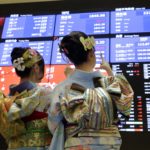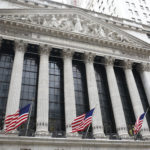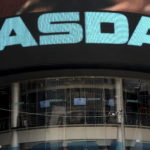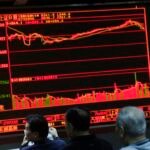The Largest Stock Markets in the World
The history of the stock market dates back over 500 years since its journey began in 1460 in Antwerp. Logically, trading has greatly transformed since then, though the most significant changes have occurred in recent decades, especially since the boom of the new technologies that have allowed time and distance to cease being factors in the stock world.

The most important stock markets in the world are essentially in North America and Asia; however, there are others of note besides them, such as the London Stock Exchange, the largest in Europe. The main stock markets are listed below:
New York Stock Exchange
Its origin dates back to an agreement between traders and brokers in 1792 to regulate the stock market, although the New York Stock Exchange would not start to operate as such until 1817, and would not receive its current name (New York Stock Exchange – NYSE) until 1863.
Nicknamed “The Big Board”, it has remained the largest stock market in the world since the end of World War I, when it surpassed the London Stock Exchange. Its market capitalization in October 2017 totaled $21.3 billion. The NYSE is headquartered at 11 Wall Street in Manhattan, and its building was recognized as a national landmark in 1978.
The opening and closing of the sessions are marked by four bells that ring when a button is pressed each day at 9:30 a.m. and 4 p.m., respectively. Each day, the bells are rung by people related to the business world, and occasionally, the New York Stock Exchange chooses personalities from other fields for this ceremony. Thus, athletes like the swimmer Michael Phelps and the baseball legend, Joe DiMaggio, artists like Liza Minelli, the rock bank Kiss, and politicians like Nelson Mandela and Kofi Annan have been protagonists of opening and closing the day on the floor of the NYSE.

The Dow Jones is the most famous stock market index and was founded in New York on May 26, 1896 by Charles Henry Dow, editor of The Wall Street Journal, which was the creator of many other indexes over the years. In the beginning, 12 companies traded on the Dow Jones, while today, 30 form part of it, of which only General Electric has remained since the beginning. The first Dow Jones index obtained a value of 40.94 points, and today, its listing stands around 25,000 points.
In 1914, and as a result of the start of World War I, the stock market suffered its first major closure in its history, and remained closed for four months and two weeks. When it reopened on December 12, it suffered the largest one-day percentage drop, when the Dow Jones index lost 24.4%.
In the waning week of October 1929, panic spread on Wall Street. Black Thursday, Monday and Tuesday led to the 1929 Stock Market Crash that would precede the most famous economic depression of the 20th Century. The results were so devastating that the Dow Jones index didn’t recover to its 1929 levels until 1954.
Like in so many other parts of society, discrimination against women was also present on Wall Street. In 1943, women were finally allowed on the floor, and in 1967, Muriel Siebert became the first female member of the New York Stock Exchange.
October 19, 1987 was the date of the so-called Black Monday, when the second-largest percentage drop in the history of Wall Street occurred, as the Dow Jones fell 22.6%.
At the end of the 20th Century, on March 29, 1999, the Dow Jones surpassed the psychological barrier of 10,000 points. Eighteen months later, the NYSE closed its activity for four days after the September 11 terrorist attack. The 20,000 point marker was first surpassed on January 25, 2017.
NASDAQ
The NASDAQ (National Association of Securities Dealers Automated Quotations) is the second-largest stock market in the world in terms of market capitalization, and like the previous one, it is located in New York, in the iconic Times Square. It was founded in 1971 by the National Association of Securities Dealers (NASD), a local group of stockbrokers. It was the first of its kind in its day because it offered a more efficient way to exchange securities by totally automating them through computers instead of by people, as was done previously. Since its inception, the Nasdaq has operated exclusively through computers and telephones.
Over time, the Nasdaq purchased other stock markets, including the those in Boston and Philadelphia, the oldest in the United States. Today, the Nasdaq stock market is the largest stock market specialized in technology in the United States, with the largest volume of trades per hour in the world, and 3,800 companies listed. In late 2017, its market capitalization was around $9.6 billion.
Its main associated indexes are the Nasdaq Composite and Nasdaq 100, but the Nasdaq Biotechnology is also noteworthy. The Nasdaq Composite is the one mentioned earlier that has around 4,000 companies listed, and is the one referred to in the news when they say ‘the Nasdaq has gone up or down’ a certain percentage point that day. For its part, the Nasdaq 100 features hundreds of the most important tech companies on its index, including Apple, Microsoft, Facebook, Tesla, Starbucks, Amazon, Comcase and Alphabet (Google), which are also some of the best known. Moreover, it is worth pointing out that the Nasdaq 100 does not include any financial companies.

Although in theory any of the main 100 non-financial companies that belong to the Nasdaq have open doors to form part of the Nasdaq 100 index, they currently do not. The reason is because although there is no minimum requirement of market capitalization. The Nasdaq 100 requires those who form part of its index—among other essential requirements—a minimum movement of 200,000 shares per day for three consecutive months.
Because the Nasdaq consists of companies of all sizes and a disparate share price, the Nasdaq 100 is a weighted index. This means that the largest companies have a greater effect on changing Nasdaq 100’s value than smaller companies. Thus, for example, in February 2015, the 10 greatest values in weight represented 47.75% of the index’s value.
Nasdaq was created in 1971 upon the request of the US Senate to the Securities Exchange Commission (SEC), due to their concern about the security of the markets. Based on the SEC study, which detected a considerable lack of transparency in unregulated markets, it proposed creating the Nasdaq on the condition that it operated automatically.
The Nasdaq opens at 9 a.m. and closes at 4:30 p.m., although including the pre- and post-market sessions, its schedule stretches from 7:00 a.m. to 8:00 p.m.
The Nasdaq Composite index stood around 7,200 points in early March 2018, though at that same time, the Nasdaq 100 was roughly 6,800.
Japan Exchange Group
Known as the Japan Exchange Group after its merger with the Osaka Securities Exchange in 2012, it was founded May 15, 1878 in the Japanese capital. It is currently the third largest stock market in the world in terms of market capitalization, and is the most important in Asia. It features more than 2,200 companies and its market capitalization was roughly $6 billion at the end of 2017.
The main indexes of the Tokyo Stock Exchange are the Nikkei 225, which is comprised of the companies chosen by Nihon Keizai Shimbun, the most important financial newspaper in Japan, and the J30, which includes the largest Japanese industrial companies. In addition, the Tokyo Stock Exchange is divided into different markets: First Section (where the most important securities are listed, Second Section (which features smaller companies), Foreign Section (comprised of foreign companies) and Mothers (which is the most innovative companies with the greatest growth).
Between August 10, 1945 and April 1, 1949, the Tokyo Stock Exchange was suspended due to the consequences of the country's participation and defeat in World War II.
As surprising as it may seem, in early 1989, Japanese stocks represented 45% of the volume of global stock markets, while 33% corresponded to the US and 9% to the United Kingdom. In 2017, the figures are totally different, as the North Americans dominate the market with 53% of the market capitalization, with just 8.4% for Japan and 6.2% for the United Kingdom. In 1988, eight of the ten largest companies in terms of market capitalization in the world were Japanese—of which five were banks—and only one, ExxonMobil, was from the United States. However, all of the companies on the top 10 were American in 2017.

The 1980’s was an unprecedented bonanza for the Nikkei index, as indicated by the fact that in September 1982, it was at 6,910 points and just 8 years later in February 1990, it had shot up to a historical high of 34,591 that has not been reached since. Two years later, in June 1992, the index had plummeted to 15,910. In early 2018, the Nikkei was around 21,000 points.
On November 1, 2005, the Tokyo Stock Exchange suffered one of the greatest technological setbacks in the history of global stock markets when the exchange systems were unusable for 4 hours due to a glitch inserted in the system by the local company Fujitsu.
Like other Asian markets, it breaks at midday to allow its employees, agents and investors to eat lunch. It is open Monday to Friday from 8 to 11:30 a.m., and from 12:30 to 5:00 p.m.
Shanghai Stock Exchange
The Shanghai Stock Exchange (SSE), founded November 26, 1990, is one of the three independently operated markets in the Popular Republic of China. The other two are the Shenzhen Stock Exchange and the Stock Exchange of Hong Kong Limited. It is the world's fourth largest in terms of market capitalization, totaling $5 billion in late 2017. Its main index is the SSE Composite, though it also has the SSE 50 and the SSE 180.
Even though China has turned into a market economy, a significant part of the Asian giant’s economy is government-controlled. This also affects its stock markets, whose values are not purely governed by market forces, because when there are signs of volatility, the government takes measures and intervenes to support the markets.
After emerging in 1990, the Shanghai Stock Exchange is still considered to be an immature market. This is shown by the fact that from the start of 2013 until mid-2105, it appreciated 250%.

Due to the particularities of the Chinese economy, foreign investors only have around 2% of the securities of the largest country in the world. Another aspect that differentiates the Shanghai Stock Exchange is that unlike most international stock markets, in this case, most of its investors are institutional. Compared to the US, where 50% of the population invests in securities, just 6% of Chinese do so.
On October 16, 2007, the SSE Composite index reached its historical maximum with 6,124,044 points, only to drop 65% in 2008 as a result of the start of the global economic crisis.
The most important company of the Shanghai Stock Exchange is PetroChina, a petroleum and gas company that employs more than a half-million people, followed in the rankings by two financial entities: the Industrial and Commercial Bank of China and the Agricultural Bank of China.
London Stock Exchange
The London Stock Exchange was founded in 1801, which makes it the oldest stock market in the world. It has a market capitalization of $4.3 billion, and its headquarters is at Paternoster Square in London. It has more than 3,000 companies from over 70 countries.
There are five LSE market indexes: FTSE 100, FTSE 200, FTSE 350, FTSE Small Cap Index and FTSE All-Share Index. Of those, the FTSE 100—commonly called the “Footsie”—is the most notable, and has the 100 most important companies of the LSE.
Though it began at the start of the 19th Century, its origin dates back to 1570, when the Royal Exchange was inaugurated, which was the stock market of that time that acted as London’s commercial center.
In World War I, the London Stock Exchange was closed from the end of July 1914 until New Year’s Day of 1915, when it was opened with severely limited restrictions, due to the fact that transactions could only be made in cash.

During World War II, the stock market only closed for six days at the start of the war, and for one more day in 1945, when its headquarters was struck by a V-2 projectile of German origin that damaged the building. Despite the damages from the projectile, stock trading remained partially active in the basement.
The LSE’s motto is the Latin expression “Dictum meum pactum” (My word is my bond), and was created in 1923 to express that one must live up to one’s word.
Until recently, the London Stock Exchange was exclusively reserved for men. It wasn't until 1973 when the first woman could form part of the organization.
Curiously, its own electronic trading platform is built on Linux (free software) and is called the Millennium Exchange.
It is open from 8 a.m. until 4:30 p.m., Monday through Friday.